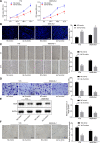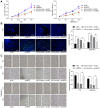Downregulation of MST4 Underlies a Novel Inhibitory Role of MicroRNA Let-7a in the Progression of Retinoblastoma
- PMID: 32539131
- PMCID: PMC7415300
- DOI: 10.1167/iovs.61.6.28
Downregulation of MST4 Underlies a Novel Inhibitory Role of MicroRNA Let-7a in the Progression of Retinoblastoma
Abstract
Purpose: Retinoblastoma (RB) is the most common intraocular malignancy in children. Deregulation of several microRNAs (miRNAs) has been identified in RB. However, the specific effect of let-7a on RB remains unclear. The present study aims to explore the effect of let-7a on malignant biological behaviors of RB cells and angiogenesis in RB.
Methods: The expressions of let-7a and mammalian sterile-20 like kinase 4 (MST4) in RB were determined with the use of real-time quantitative polymerase chain reaction (RT-qPCR) and Western blot analysis. Next, in order to explore effects of let-7a and MST4 on RB cellular functions, RB cells were transfected with let-7a-mimic, let-7a inhibitor, si-MST4, or co-transfected with let-7a-mimic and oe-MST4 plasmids. Subsequently, the interaction among let-7a, MST4, and the MAPK signaling pathway was evaluated by RT-qPCR, dual-luciferase reporter gene assay, and Western blot analysis. Finally, the effects of let-7a and MST4 were further confirmed in vivo by injecting nude mice with RB cells stably expressing let-7a agomir or sh-MST4.
Results: Rb tissues and cells presented with downregulated Let-7a and upregulated MST4. Let-7a negatively targeted MST4 to block the activation of the MAPK signaling pathway. Upregulation of let-7a promoted apoptosis, and facilitated proliferation, angiogenesis, migration, and invasion of RB cells by decreasing MST4. Elevation of let-7a or silencing MST4 restricted angiogenesis and tumorigenesis in RB mice.
Conclusions: Taken together, let-7a inhibits angiogenesis in RB by silencing MST4 and inhibiting the MAPK signaling pathway.
Conflict of interest statement
Disclosure:
Figures








References
-
- Benavente CA, Dyer MA.. Genetics and epigenetics of human retinoblastoma. Annu Rev Pathol. 2015; 10: 547–562. - PubMed
-
- Kent OA, Mendell JT.. A small piece in the cancer puzzle: microRNAs as tumor suppressors and oncogenes. Oncogene. 2006; 25: 6188–6196. - PubMed
-
- Golabchi K, Soleimani-Jelodar R, Aghadoost N, et al. .. MicroRNAs in retinoblastoma: potential diagnostic and therapeutic biomarkers. J Cell Physiol. 2018; 233: 3016–3023. - PubMed
-
- Sung V, Luo W, Qian D, et al. .. The Ste20 kinase MST4 plays a role in prostate cancer progression. Cancer Res. 2003; 63: 3356–3363. - PubMed
Publication types
MeSH terms
Substances
LinkOut - more resources
Full Text Sources

